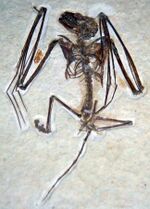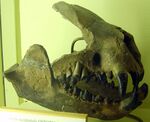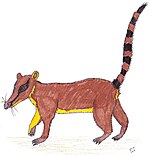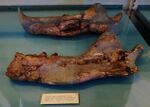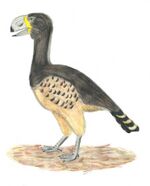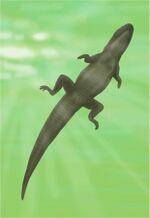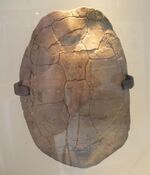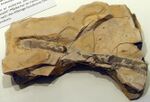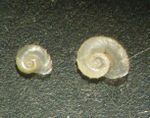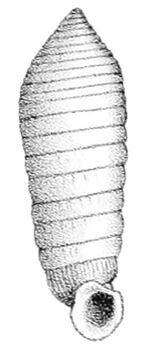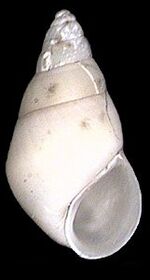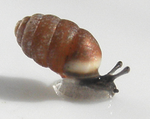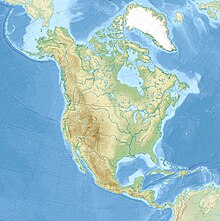Earth:Willwood Formation
| Willwood Formation Stratigraphic range: Thanetian-Ypresian (Clarkforkian-Bridgerian) ~56–48 Ma | |
|---|---|
| Type | Geological formation |
| Sub-units | Gray Bull beds, Sand Coulee beds, Sand Creek Facies, Wa-1 Zone |
| Lithology | |
| Primary | Mudstone, shale |
| Other | Sandstone, conglomerate |
| Location | |
| Coordinates | [ ⚑ ] : 44°30′N 108°00′W / 44.5°N 108.0°W |
| Paleocoordinates | [ ⚑ ] 49°12′N 90°48′W / 49.2°N 90.8°W |
| Region | |
| Country | |
| Extent | Bighorn Basin |
| Type section | |
| Named for | Shale, mudstone, limestone |
| Lua error in Module:Location_map/multi at line 27: Unable to find the specified location map definition: "Module:Location map/data/Wyoming" does not exist. | |
The Willwood Formation is a sedimentary sequence deposited during the late Paleocene to early Eocene, or Clarkforkian, Wasatchian and Bridgerian in the NALMA classification.[1][2]
Description
It consists of fine grained clastic rocks (mudstone and shale) interbedded with medium grained clastic rocks (sandstone) and sporadic conglomerates. The formation underlies portions of the Bighorn Basin of Big Horn, Hot Springs, Park and Washakie counties of Wyoming.[3]
Dating
Radiometric dating of volcanic tuffs, combined with comparisons with other formations using magnetostratigraphy, using numerous samples from various levels of the formation suggest an age range of 55 – 52 million years ago, placing the Paleocene-Eocene boundary near the base of the formation.[4]
Fossil content
Trace fossils have been found in the Willwood Formation.[5] Fossil birds include Gastornis, Neocathartes and Paracathartes. A fossil alligatorid, namely Orthogenysuchus, was also found in this formation.
Mammals
Afrotheres
| Afrotheres reported from the Willwood Formation | |||||
|---|---|---|---|---|---|
| Genus | Species | Presence | Material | Notes | Images |
| Apheliscus | A. sp. | Upper Gray Bull.[6] | A macroscelidean. | ||
Apatotheres
| Apatotheres reported from the Willwood Formation | |||||
|---|---|---|---|---|---|
| Genus | Species | Presence | Material | Notes | Images |
| Apatemys | A. bellulus | Lysite and Lost Cabin Zone.[7] | Also found in the Wind River Formation.[7] | ||
| A. chardini | Middle and possibly lower Gray Bull zone.[7] | The smallest species of the genus.[7] | |||
| A. kayi | The oldest known species of the genus.[7] | ||||
| A. sp., cf. A. rodens | Eastern side of Red Butte, and north of Sheep Mountain.[7] | YPM 23476, 30582, AMNH 48999.[7] | 3 very large specimens of Apatemys.[7] | ||
Bats
| Bats reported from the Willwood Formation | |||||
|---|---|---|---|---|---|
| Genus | Species | Presence | Material | Notes | Images |
| cf. Icaronycteris | cf. I. sp. | Locality SC-29, Park County, Wyoming.[8] | 3 fragmentary specimens.[8] | ||
Cimolestans
| Cimolestans reported from the Willwood Formation | |||||
|---|---|---|---|---|---|
| Genus | Species | Presence | Material | Notes | Images |
| Azgonyx | A. gunnelli | Localities SC-67, SC-308 and SC-351.[9] | A tillodont. | ||
| A. sp. | Locality SC-67.[9] | A larger tillodont than A. gunnelli. | |||
| Coryphodon | C. sp. | Localities FG-61, SC-67 and SC-139.[9] | [10] | A pantodont. | |
| Didelphodus | D. absarokae | Lower Gray Bull to the upper part of the Lysite zones.[7] | A palaeoryctid. | ||
| Ectoganus | E. bighornensis | Localities HG-3 and SC-67.[9] | A taeniodont. | ||
| E. copei | USGS 3838, with postcrania.[10] | A taeniodont. | |||
| E. gliriformis | A fragmentary femur (PU 13173).[10] | A taeniodont. | |||
| Esthonyx | E. bisculatus | Jaws, teeth and a few postcranial remains.[10] | A tillodont. | ||
| E. spatularius | Bighorn Basin,[11] and locality SC-67.[9] | Fragmentary left dentary.[9] | A tillodont. | ||
| Megalesthonyx | M. hopsoni | Buffalo Basin.[12] | A tillodont. | ||
| cf. Palaeoryctes | cf. P. sp. | "USGSD 1661, 2151, 3711".[7] | A palaeoryctid. | ||
| Palaeosinopa | P. incerta | Lower to upper Gray Bull zone,Bighorn Basin.[7][13] | A pantolestid also found in the Wind River and San Jose formations.[7] | ||
| P. lutreola | Middle and upper Gray Bull zone, Bighorn Basin.[7][13] | A pantolestid. | |||
| P. veterrima | Lower Gray Bull through Lysite zones, Bighorn Basin.[7][13] | More than 50 specimens.[7] | A pantolestid. | ||
| P. sp. | Lower part of the formation.[6] | UM 69722 (a partial skull and mandible).[6] | A pantolestid. | ||
| cf. Pararyctes | cf. P. sp. | "Yale locality 363 at the 190-m level of the Willwood Formation in the Elk Creek Facies".[7] | UW 7028.[7] | A palaeoryctid. | |
Eulipotyphlans
| Eulipotyphlans reported from the Willwood Formation | |||||
|---|---|---|---|---|---|
| Genus | Species | Presence | Material | Notes | Images |
| Auroralestes | A. simpsoni | Lower part of the formation, Sand Creek Facies.[7] | UW 9616 (right P4-M2) and YPM 35156.[7] | An erinaceid, originally named Eolestes. | |
| Batodonoides | B. vanhouteni | Locality SC-303, situated at the 2,110 m level of the formation.[14] | Maxilla and dentaries.[14] | A geolabidid. | |
| Centetodon | C. neashami | "Lower middle Gray Bull and upper Gray Bull zones".[7] | A geolabidid. | ||
| C. patratus | UCMP 44954 and YPM 23088, possibly also UCMP 44957, 44958, 44959.[7] | A geolabidid. | |||
| Creotarsus | C. lepidus | "Lower Gray Bull beds, Coon Creek, Garland Road, Bighorn Basin".[7] | "AMNH 16169, left ramus with P4-M2, and associated tarsal bones".[7] | An animal of enigmatic affinities but may be an erinaceomorph. | |
| cf. Dartonius | cf. D. jepseni | "YPM 30559, fragment of left ramus with P4-M1 and trigonid of M2".[7] | An erinaceid, originally referred to as "Leptacodon" jepseni.[15] | ||
| Dormaaliidae | Dormaaliid, sp. A | Sand Creek Facies.[7] | UW 7048, 9627.[7] | An amphilemurid. | |
| Eolestes | E. simpsoni | Lower part of the formation, Sand Creek Facies.[7] | UW 9616 (right P4-M2) and YPM 35156.[7] | Now renamed to Auroralestes. | |
| Insectivora (?) | gen. et. sp. indeterminate | YPM locality 355, lower part of the middle Gray Bull zone.[7] | "YPM 30860, fragment of right ramus with M1(?) and trigonid of M2(?)".[7] | Teeth which may represent an unusual insectivore or microchiropteran. | |
| cf. Leipsanolestes | cf. L. sp. | Sand Creek Facies.[7] | UW 9672, a left molar.[7] | An erinaceid. | |
| Leptacodon | cf. "L." jepseni | "YPM 30559, fragment of left ramus with P4-M1 and trigonid of M2".[7] | Actually an erinaceid, now reassigned to a new genus, Dartonius.[15] | ||
| L. rosei | Localities SC-188 and SC-29, Park County, Wyoming.[8] | 3 dentaries, 2 maxillae, several isolated teeth and possibly a metatarsal.[8] | A nyctitheriid. | ||
| Cf. L. sp. | A single lower molar.[8] | A nyctitheriid. | |||
| Limaconyssus | L. habrus | Locality SC-29, Park County, Wyoming.[8] | Left dentary.[8] | A nyctitheriid. | |
| Macrocranion | M. nitens | Uppermost part of the lower Gray Bull zone to the upper part of the Lysite zone.[7] | An amphilemurid. | ||
| Parapternodus | P. antiquus | Lower part of the formation.[7] | YPM 31169, fragment of left ramus with M2-3.[7] | An apternodontid. | |
| Plagioctenodon | P. krausae | Sand Creek Facies.[7] | A nyctitheriid. | ||
| cf. P. krausae | Locality SC-29, Park County, Wyoming.[8] | An isolated first or second lower incisor and the buccal half of an upper molar.[8] | A nyctitheriid. | ||
| P. savagei | YPM locality 104, lower part of the formation.[7] | "YPM 34257, right P3-M2".[7] | A nyctitheriid. | ||
| Pontifactor | P. sp. | "UW 8584, 9621, 9649, 9681, 9683, 9710, 9721, 9732, 9733, 10449, 10455, 10456".[7] | A nyctitheriid. | ||
| Scenopagus | S. hewettensis | UW locality V -73020.[7] | UW 8998 and possibly UW 9738, 10450.[7] | An amphilemurid. | |
| S. sp. | Middle Gray Bull zone.[7] | An amphilemurid, at least 2 species represented by inadequate material, at least one is probably new.[7] | |||
| Talpavoides | T. dartoni | Lower part of the formation.[7] | An amphilemurid. | ||
| Wyonycteris | W. chalix | Locality SC-29, Park County, Wyoming.[8] | "UM 76910, a right dentary".[8] | A nyctitheriid, originally believed to be a bat. | |
Ferae
| Ferae reported from the Willwood Formation | |||||
|---|---|---|---|---|---|
| Genus | Species | Presence | Material | Notes | Images |
| Acarictis | A. ryani | Locality SC-67.[9] | A broken right molar and a left molar.[9] | A hyaenodont. | |
| Alocodontulum | A. atopum | YRM 30790 and USGS 7208.[10] | A palaeanodont. | ||
| Arfia | A. junnei | Localities SC-67, SC-69, SC-79, SC-121, SC-308 and SC-348.[9] | A hyaenodont. | ||
| A. sp. | Southern Bighorn Basin.[10] | Fragmentary postcranial remains.[10] | A hyaenodont. | ||
| Cf. Asiabradypus | Cf. A. sp. | Locality SC-67.[9] | An edentulous right lower jaw (UM 87859m).[9] | A palaeanodont. | |
| Didymictis | D. leptomylus | Localities MP-40, SC-67 and SC-79.[9] | Skull and teeth.[9] | A viverravid. | |
| D. protenus | Multiple postcranial specimens.[10] | A viverravid. | |||
| Dipsalidictis | D. platypus | Localities SC-67 and SC-141.[9] | An oxyaenid. | ||
| D. transiens | Localities SC-79 and SC-67.[9] | An upper left canine and a trigonid of a molar.[9] | An oxyaenid. | ||
| Miacis | M. winkleri | Localities SC-67, SC-348 and SC-350.[9] | 3 fragmentary dentaries.[9] | A miacid. | |
| cf. M. sp. | USGS 7161.[10] | A miacid. | |||
| Oxyaena | O. forcipata | Relatively complete skeletal remains.[10] | An oxyaenid. | ||
| O. gulo | USGS 7186.[10] | An oxyaenid. | |||
| O. intermedia | Fragmentary postcrania.[10] | An oxyaenid. | |||
| O. platypus | [10] | Now moved to the genus Dipsalidictis. | |||
| Palaeanodon | P. ignavus | Partial skeletons including postcrania.[10] | A palaeanodont. | ||
| P. nievelti | Localities SC-67 and SC-121.[9] | A palaeanodont. | |||
| Palaeonictis | P. occidentalis | "Hind foot skeleton and associated fragments".[10] | An oxyaenid. | ||
| P. sp. | Locality SC-67.[9] | Trigonid of a right molar.[9] | An oxyaenid. | ||
| Prolimnocyon | P. atavus | Bighorn Basin.[16] | Partial skeleton.[16] | A hyaenodont. | |
| P. eerius | Localities SC-67 and possibly SC-139.[9] | Crushed skull.[9] | A hyaenodont. | ||
| Prototomus | P. deimos | Localities SC-67 and SC-349.[9] | 4 fragmentary specimens.[9] | A hyaenodont. | |
| P. sp. | 4 specimens.[10] | A hyaenodont. | |||
| Tritemnodon | T. sp. | 2 specimens with postcrania.[10] | A hyaenodont. | ||
| ?Uintacyon | ?U. sp. | [10] | A miacid. | ||
| Viverravus | V. bowni | Locality SC-67,[9] and locality SC-29, Park County, Wyoming.[8] | A viverravid. | ||
| V. politus | Locality SC-67.[9] | A left maxilla.[9] | A viverravid. | ||
| Vulpavus | cf. V. canavus | 3 specimens.[10] | A miacid. | ||
Leptictids
| Leptictids reported from the Willwood Formation | |||||
|---|---|---|---|---|---|
| Genus | Species | Presence | Material | Notes | Images |
| Palaeictops | P. bicuspis | Also found in the Wind River Formation.[7] | |||
| Prodiacodon | P. tauricinerei | Mostly in the Gray Bull zone, one or two specimens in the Bighorn Basin Lysite zone.[7] | |||
| P. sp. | Middle Gray Bull zone.[7] | YPM 26013, 26040, possibly 26026.[7] | |||
Marsupials
| Marsupials reported from the Willwood Formation | |||||
|---|---|---|---|---|---|
| Genus | Species | Presence | Material | Notes | Images |
| Mimoperadectes | M. labrus | Localities SC-67 and SC-69.[9] | Left dentary.[9] | ||
| Peradectes | P. cf. P. chesteri | 2 isolated teeth.[8] | |||
Multituberculates
| Multituberculates reported from the Willwood Formation | |||||
|---|---|---|---|---|---|
| Genus | Species | Presence | Material | Notes | Images |
| Ectypodus | E. powelli | Locality SC-29, Park County, Wyoming.[8] | 10 isolated teeth from at least 2 individuals.[8] | A neoplagiaulacid. | |
| E. tardus | Locality SC-67.[9] | Tooth crowns.[9] | A neoplagiaulacid. | ||
Primatomorphs
| Primatomorphs reported from the Willwood Formation | |||||
|---|---|---|---|---|---|
| Genus | Species | Presence | Material | Notes | Images |
| Absarokius | A. abbotti | [17] | An omomyid. | ||
| A. metoecus | [17] | An omomyid. | |||
| Anemorhysis | A. pattersoni | Upper part of the formation.[18] | An omomyid. | ||
| A. wortmani | Upper part of the formation.[18] | An omomyid. | |||
| Arapahovius | A. advena | Northwest Wyoming.[17] | An omomyid. | ||
| Arctodontomys | A. wilsoni | Locality SC-67.[9] | Small sample of teeth.[9] | A microsyopid. | |
| Bownomomys | B. americana | [17] | An omomyid, formerly listed as a species of Teilhardina. | ||
| B. crassidens | [17] | An omomyid, formerly listed as a species of Teilhardina. | |||
| Cantius | C. abditus | A substantially complete skull and mandible.[19] | An adapiform. | ||
| C. torresi | Localities SC-67 and SC-69.[9] | An adapiform. | |||
| Carpolestes | C. cf. C. nigridens | Locality SC-29, Park County, Wyoming.[8] | A right dentary.[8] | A carpolestid. | |
| Chlororhysis | C. incomptus | Upper part of the formation.[18] | An omomyid. | ||
| Micromomys | M. willwoodensis | Clark's Fork Basin.[20] | A micromomyid. | ||
| Microsyops | M. latidens | Southern Bighorn Basin.[21] | Over a thousand specimens.[21] | A plesiadapiform. | |
| Cf. Niptomomys | Cf. N. sp. | Locality SC-67.[9] | An edentulous right dentary.[9] | A microsyopid. | |
| Phenacolemur | P. praecox | Localities SC-67 and SC-348.[9] | Right and left dentaries.[9] | A paramomyid. | |
| P. willwoodensis | Upper part of the formation.[22] | A paramomyid. | |||
| Pseudotetonius | P. ambiguus | [17] | An omomyid. | ||
| Steinius | S. annectens | Northwest Wyoming.[17] | An omomyid. | ||
| S. vespertinus | "AMNH 16835, fragment of a left ramus with M1 through M3".[6] | An omomyid. | |||
| Strigorhysis | S. sp., cf. S. bridgerensis | [17] | An omomyid. | ||
| Tatmanius | T. szalayi | Northwest Wyoming.[17] | An omomyid. | ||
| Teilhardina | T. americana | [17] | Now moved to the genus Bownomomys. | ||
| T. crassidens | [17] | Now moved to the genus Bownomomys. | |||
| T. tenuicula | [17] | An omomyid. | |||
| Tetonius | T. homunculus | [17] | An omomyid. | ||
| T. matthewi | [17] | An omomyid. | |||
| T. sp. | [17] | An omomyid. | |||
| Tinimomys | T. graybullensis | The lingual half of a right upper molar.[8] | A microsyopid. | ||
| Worlandia | cf. W. sp. | Locality SC-29, Park County, Wyoming.[8] | 2 isolated teeth.[8] | A plagiomenid colugo. | |
Rodents
| Rodents reported from the Willwood Formation | |||||
|---|---|---|---|---|---|
| Genus | Species | Presence | Material | Notes | Images |
| Acritoparamys | Cf. A. atavus | Locality SC-67.[9] | A small isolated lower incisor (UM 86003m).[9] | ||
| A. atwateri | Localities SC-67, SC-308 and SC-351.[9] | Several dentaries and teeth.[9] | |||
| Franimys | F. sp. | "ACM 10524 (a skull with the right P4 and M2-M3, edentulous mandible, and several postcranial elements)".[6] | |||
| Notoparamys | N. costilloi | Upper part of the formation.[23] | 18 specimens.[23] | Also known from the Huerfano Formation. "Pseudotomus" coloradensis and Leptotomus loomisi are probably junior synonyms.[23] | |
| Paramys | P. taurus | Localities SC-67, SC-139 and SC-350.[9] | Jaw fragments and incisors.[9] | ||
Ungulates
| Ungulates reported from the Willwood Formation | |||||
|---|---|---|---|---|---|
| Genus | Species | Presence | Material | Notes | Images |
| Anacodon | A. ursidens | [10] | An arctocyonid. | ||
| Bunophorus | cf. B. grangeri | USGS 16470 (a very incomplete skeleton).[10] | A dichobunid originally listed as cf. Wasatchia dorseyana. | ||
| Cardiolophus | C. radinskyi | UM 64913.[24] | An isectolophid. | ||
| Copecion | C. davisi | Localities BR-2, SC-51, SC-67, SC-69, SC-79, SC-139, SC-308, SC-345, SC-348, SC-349 and SC-351.[9] | A phenacodontid. | ||
| Chriacus | C. badgleyi | Localities SC-67, SC-79, SC-121 and SC-342.[9] | An arctocyonid. | ||
| C. sp. | Several skeletal specimens.[10] | An arctocyonid. | |||
| Diacodexis | D. ilicis | Localities SC-67 and SC-308.[9] | A dichobunid. | ||
| D. metsiacus | Several specimens, including a near-complete skeleton.[10] | A dichobunid. | |||
| Dissacus | D. praenuntius | Park County, Wyoming.[9][25] | Teeth, jaw elements & bone fragments.[9][25] | A mesonychid. | |
| D. serior | USGS locality D-1754, Bighorn Basin, Wyoming.[25] | Left dentary fragments (USGS 27612).[25] | A mesonychid. | ||
| D. willwoodensis | Bighorn Basin, Wyoming.[25] | Mandibles.[25] | A mesonychid. | ||
| Ectocion | E. osbornianus | Locality SC-67 and SC-351.[9] | 2 fragmentary dentaries.[9] and a single postcranial association.[10] | A phenacodontid. | |
| E. parvus | Localities HG-3, SC-67, SC-69, SC-121, SC-139, SC-182, SC-308 and SC-351.[9] | A phenacodontid. | |||
| Hapalodectes | H. anthracinus | University of Wyoming locality V-73086, Wyoming.[25] | Teeth (USGS 9628).[25] | A mesonychian | |
| H. leptognathus | A fragmentary specimen (USGS 5912).[10] | A mesonychian. | |||
| Heptodon | cf. H. calciculus | Wind River Basin.[10] | Remains of a subadult with postcrania.[10] | ||
| Homogalax | H. protapirinus | Bighorn Basin.[26] | A skull (YPM(PU) 16168),[26] and several other specimens.[27][24] | An isectolophid. | |
| cf. H. protapirinus | At least 2 specimens.[10] | An isectolophid. | |||
| Hyopsodus | H. loomisi | Localities SC-67, SC-69, SC-79, SC-121, SC-308 and SC-342.[9] | A hyopsodontid. | ||
| H. powellianus | "AMNH 4147, right mandible fragment with M1 through M3".[6] | A hyopsodontid. | |||
| Hyracotherium | H. grangeri | Locality SC-67.[9] | 2 isolated teeth.[9] | An equid. | |
| H. sandrae | Localities FG-61, SC-67, SC-69, SC-79, SC-121 and SC-139.[9] | An equid. | |||
| H. sp. | Skeletal remains with postcrania.[10] | An equid. | |||
| Meniscotherium | M. priscum | Locality SC-67(?)[9] | Left dentary fragment.[9] | A phenacodontid. | |
| Pachyaena | P. gigantea | YPM localities 131 & 149, Wyoming.[25] | Jaw elements & teeth.[25] | A mesonychid. | |
| P. gracilis | USGS locality D-1640.[25] | Maxillary fragments (USGS 7185).[25] | A mesonychid. | ||
| P. ossifraga | Locality SC-348.[9] | Trigonid of a right molar.[9] | A mesonychid. | ||
| P. sp. | Postcranial material.[10] | A mesonychid. | |||
| Phenacodus | P. cf. P. intermedius | Localities SC-67 and SC-141.[9] | A phenacodontid. | ||
| P. primaevus | Near complete skeletons.[10] | A phenacodontid. | |||
| P. vortmani | Near complete skeletons.[10] | A phenacodontid. | |||
| Princetonia | P. yalensis | Locality SC-121(?)[9] | Right dentary.[9] | An arctocyonid. | |
| Thryptacodon | T. antiquus | [10] | An arctocyonid. | ||
| T. barae | Localities MP-38 and SC-121.[9] | An arctocyonid. | |||
| T. olseni | [10] | An arctocyonid. | |||
| T. sp. | 2 partial skeletons.[10] | An arctocyonid. | |||
| Wasatchia | cf. W. dorseyana | USGS 16470 (a very incomplete skeleton).[10] | Now a junior synonym of Bunophorus. | ||
| Xenicohippus | Lower part of the Upper Willwood Formation.[28] | A hyracotheriine. | |||
Reptiles
Birds
| Birds reported from the Willwood Formation | |||||
|---|---|---|---|---|---|
| Genus | Species | Presence | Material | Notes | Images |
| Anachronornis | A. anhimops | Clark Quadrangle, Park County, Wyoming.[29] | USNM 496700.[29] | An anseriform. | |
| Anseriformes Familia Incertae sedis | Clark Quadrangle, Park County, Wyoming.[29] | USNM 496701 (right quadrate missing the pterygoid condyle); USNM 496702 (fragmentary right femur consisting of only the proximal and distal ends).[29] | Generally similar to Anachronornis & Danielsavis.[29] | ||
| Aves indet. | Localities SC-67 and SC-121.[9] | A cervical vertebra and proximal part of a carpometacarpus.[9] | An indeterminate bird. | ||
| Calcardea | C. junnei | "UM 76882, anterior part of sternum, partial left coracoid. nearly complete right coracoid, partial left humerus. two nearly complete vertebrae. fragmentary left and right tarsometatarsi, and several phalanges, all probably representing a single individual bird."[8] | Originally thought to be a heron, now thought to be related to Vastanavis.[30] | ||
| Diatryma | D. gigantea | Several specimens.[31] | Now deemed a junior synonym of Gastornis. | ||
| Eogeranoides | E. campivagus | "Fragmentary tibiotarsus and tarsometatarsus remains".[32] | A dubious geranoidid, may be a junior synonym of Paragrus prentici. | ||
| Gastornis | G. gigantea | Several specimens.[31] | A gastornithiform. | ||
| Geranoides | G. jepseni | Elk Creek, Bighorn Basin.[32] | A geranoidid, now deemed a junior synonym of Palaeophasianus meleagroides. | ||
| Microolithus | M. wilsoni | Partial eggs.[33] | Fossil bird eggs. | ||
| Palaeophasianus | "P." incompletus | "A fragmentary distal end of a tarsometatarsus".[32] | A very large possible geranoidid, may actually belong to the genus Paragrus or be outside Geranoididae entirely. | ||
| P. meleagroides | Elk Creek, Bighorn Basin.[32] | A geranoidid. | |||
| ?P. sp. | AMNH 5156.[32] | A geranoidid. | |||
| Paracathartes | P. howardae | [34] | A lithornithid. | ||
| Paragrus | P. prentici | [32] | A geranoidid. | ||
| Primoptynx | P. poliotauros | Specimen including all major postcranial bones.[35] | A large owl. | ||
| Sandcoleus | S. copiosus | Clark Quadrangale, Park County, Wyoming.[36] | "Two articulated partial skeletons and a number of other elements".[36] | A sandcoleid mousebird. | |
Crocodilians
| Crocodilians reported from the Willwood Formation | |||||
|---|---|---|---|---|---|
| Genus | Species | Presence | Material | Notes | Images |
| Allognathosuchus | A. sp. | Localities SC-67, SC-139, SC-342 and SC-349.[9] | An alligatorid. | ||
| Crocodilia indet. | Localities SC-67, SC-69 and SC-121.[9] | Dermal scutes and vertebral centra.[9] | May represent either large Allognathosuchus or small Leidyosuchus. | ||
| Leidyosuchus | L. sp. | Localities SC-67, SC-79, SC-139, SC-342, SC-345 and SC-350.[9] | |||
| Orthogenysuchus | O. olseni | [37] | A caiman. | ||
| Pristichampsus | P. sp. | Locality SC-348.[9] | A single tooth (UM 83817m).[9] | ||
Squamates
| Squamates reported from the Willwood Formation | |||||
|---|---|---|---|---|---|
| Genus | Species | Presence | Material | Notes | Images |
| Anguidae indet. | 2 fragmentary dentaries (UM 76872 and 76873).[8] | A very small anguid lizard.[8] | |||
| Anguimorpha | A dentary, maxilla and 1 or 2 premaxillae (UM 76874-76875, 76878-76879(?), and 768811).[8] | A gerrhonotine or diploglossine.[8] | |||
| Anguimorph CG | "UCMP 150871, 150872 (jaw frag-ments), 150920 (jaw fragment), 150969 (parietal fragment),151038 (left frontal), 151067 (right maxilla fragment), 151095 (right maxilla fragment), 167499 (right maxilla fragment), 167553 (left maxilla fragment)".[38] | ||||
| Anniealexandria | A. gansi | UCMP locality V99019.[38] | Skull fragments and vertebrae.[38] | An amphisbaenian. | |
| Anolbanolis | A. banalis | UCMP locality V99019.[38] | An iguanian. | ||
| Apodosauriscus | A. thermophilus | UCMP locality V99019.[38] | Skull fragments.[38] | An anguid. | |
| Blutwurstia | B. oliviae | Clarks Fork Basin.[39] | A xenosaurid. | ||
| cf. Eodiploglossus | cf. E. sp. CG | "UCMP 150916 (right maxilla fragment), 150919 (right frontal), 150962 (partial left frontal), 151070, 151071 (skull fragments), 167338 (partial right frontal), 167426 (left maxilla fragment), 167447 (left maxilla fragment), 167456 (jaw fragment),?167527 (right pterygoid fragment), 167602 (right dentary fragment), 400180 (right maxilla fragment)".[38] | An anguid. | ||
| Gaultia | G. silvaticus | UCMP locality V99019.[38] | A glyptosaurine. | ||
| Gerrhonotinae | Gerrhonotine CG | Skull fragments.[38] | An alligator lizard. | ||
| Glyptosaurinae | Glyptosaurine CG | "UCMP 151033 (right maxilla fragment), ?151068 (left pterygoid fragment), 151935 (parietal fragment), 167269 (parietal fragment),?167613 (right palatine fragment)."[38] | A glyptosaurine. | ||
| Iguanidae | Iguanid CG | "UCMP 151078 (right dentary fragment), 400156 (partial right postorbital), 400169 (partial right squamosal)".[38] | An iguanid lizard. | ||
| Lacertilia indet. | Localities SC-67 and SC-308.[9] | Vertebrae.[9] | Indeterminate lizards. | ||
| Melanosaurus | M. maximus | A frontal, numerous osteoderms and vertebrae.[9] | A glyptosaurine. | ||
| Palaeoxantusia | P. sp. CG | Skull fragments.[38] | A night lizard. | ||
| Proxestops | Cf. P. sp. | Locality MP-40.[9] | UM 88170m (2 osteoderms).[9] | A glyptosaurine. | |
| P. sp. CG | Skull fragments.[38] | A glyptosaurine. | |||
| Provaranosaurus | cf. P. sp. CG | "UCMP 167299 (right dentary fragment)".[38] | A xenosaurid. | ||
| cf. Saniwa | cf. S. sp. CG-1 | "UCMP 150921 (jaw fragment with partial tooth), 151099 (premaxilla), 167572 (jaw fragment with tooth)".[38] | A varanid. | ||
| cf. S. sp. CG-2 | "UCMP 150873 (right dentary fragment with tooth), 150971 (tooth), 167324 (distal right humerus), 167336 (edentulous left dentary fragment), 167355 (parietal fragment)".[38] | A varanid. | |||
| Suzanniwana | S. patriciana | UCMP locality V99019.[38] | An iguanid. | ||
| Varanoidea | A dentary and maxilla (UM 76876 and 768771).[8] | One or possibly 2 species of Parasaniwa or Provaranosaurus-like varanoids.[8] | |||
| Xantusiidae | Xantusiid CG | "UCMP 150827 (right maxilla fragment), 150965 (maxilla fragment), 150970 (right maxilla fragment), 167413 (left frontal fragment), 167495 (right maxilla fragment), 167575 (premaxilla), 167599 (right maxilla fragment), 167600 (left maxilla fragment)".[38] | A night lizard. | ||
Testudines
| Testudines reported from the Willwood Formation | |||||
|---|---|---|---|---|---|
| Genus | Species | Presence | Material | Notes | Images |
| Chelonia indet. | Localities SC-67, SC-121 and SC-348.[9] | Several pieces of the carapace and plastron.[9] | Indeterminate medium to large turtles. | ||
| Echmatemys | E. sp. | Locality SC-67.[9] | Much of the plastron and several peripherals or pleurals from the carapace (UM 83627), and a peripheral (UM 66617m).[9] | ||
| Gomphochelys | G. nanus | Southeastern Bighorn Basin, Washakie County, Wyoming.[40] | A dermatemydid. | ||
| Cf. Plastomenus | Cf. P. sp. | Localities SC-67 and SC-350.[9] | Fragmentary pieces of the carapace and plastron.[9] | A trionychid. | |
Amphibians
| Amphibians reported from the Willwood Formation | |||||
|---|---|---|---|---|---|
| Genus | Species | Presence | Material | Notes | Images |
| Anura | Distal end of a humerus (UM 76883).[8] | A small frog. | |||
| Urodela | Numerous vertebrae, UM 76871 (a-j).[8] | A small salamander. | |||
Fish
| Fish reported from the Willwood Formation | |||||
|---|---|---|---|---|---|
| Genus | Species | Presence | Material | Notes | Images |
| Amia | A. sp. | Localities SC-67 and SC-342.[9] | Isolated cervical vertebrae, and a concretion of broken bones including 1 or 2 tooth-bearing bones likely belonging to Amia. | A bowfin. | |
| Cuneatus | C. maximus | [41] | A large gar. | ||
| Lepisosteus | L. sp. | "Mostly diamond-shaped ganoid scales, but some specimens include distinct opisthocoelous vertebrae, basioccipitals and other cranial elements."[9] | A gar. | ||
Invertebrates
Invertebrate ichnotaxa
| Invertebrate ichnotaxa reported from the Willwood Formation | |||||
|---|---|---|---|---|---|
| Ichnogenus | Ichnospecies | Presence | Material | Notes | Images |
| Camborygma | C. litonomos | Polecat Bench.[42] | Prismatic cylindrical structures.[42] | Likely represent crayfish burrows.[43][42] | |
| Cocoon traces | Polecat Bench.[44] | ||||
| Cf. Cylindricum | Cf. C. isp. | Polecat Bench.[44] | "Predominantly vertical, straight to sinuous, unbranched, unlined, and smooth walled shafts with circular cross sections and gently rounded, unenlarged terminations".[42] | Burrows possibly created by beetles, hymenopterans, emerging cicada nymphs, spiders or molluscs.[42] | |
| Edaphichnium | E. lubricatum | Polecat Bench.[44] | "Tubular burrows with ellipsoidal fecal pellets".[45] | Formed by substrate feeding by Earthworms or other invertebrates. | |
| Naktodemasis | N. bowni | Bighorn Basin.[46] | "Burrows composed of nested ellipsoidal packets backfilled with thin, tightly spaced, menisci subparallel to the bounding packet."[46] | Burrows likely constructed by burrowing bugs or cicada nymphs.[42][46] | |
| cf. Planolites | cf. P. isp. | Polecat Bench.[44] | Traces made by the feeding of worm-like animals. | ||
| cf. Steinchnus | S. isp. | Polecat Bench.[44] | Traces made by invertebrates, possibly beetles or mole crickets. | ||
Gastropods
| Gastropods reported from the Willwood Formation | |||||
|---|---|---|---|---|---|
| Genus | Species | Presence | Material | Notes | Images |
| Cf. Albertanella | Cf. A. minuta | [8] | A pupillid. | ||
| Discus | D. ralstonensis | Many individuals (some juvenile specimens).[8] | An endodontid. | ||
| Elimia or Pleurocera | E. or P. sp. | Some 25 specimens, many are internal molds.[9] | A pleurocerid. | ||
| Grangerella | cf. G.(?) phenacodorum | 2 specimens originally referred to Protoboysia complicata.[8] | A grangerellid. | ||
| G. sinclairi | [8] | A grangerellid. | |||
| Cf. Gyraulus | Cf. G. sp. | Locality SC-69.[9] | A poorly-preserved planispiral internal mold.[9] | A pulmonatan. | |
| Hendersonia | H. evanstonensis | Several specimens, none preserving the operculum.[8] | A helicinid. | ||
| Holospira | H. sp. | Localities SC-67, SC-139, SC-345 and SC-349.[9] | 7 individuals.[9] | An urocoptid. | |
| "Hydrobia" | "H." sp. | Locality SC-69.[9] | "A very small, dextral, high-spired shell with 9 whorls".[9] | A hydrobiid. | |
| Cf. Microphysula | Cf. M. sp. | A single individual.[8] | A sagdid. | ||
| Oreohelix | O. megarche | A single specimen (UM(I) 65404).[8] | An oreohelicid. | ||
| Cf. Pupilla | Cf. P. sp. | UM(I) 654071.[8] | A pupillid. | ||
Plants
| Plants reported from the Willwood Formation | |||||
|---|---|---|---|---|---|
| Genus | Species | Presence | Material | Notes | Images |
| Celtis | C. phenacodorum | Endocarps.[9] | An urticale. | ||
Wasatchian correlations
| Basin | Powder River Uinta Piceance Colorado Plateau Wind River Green River Bighorn |
Piceance |
Colorado Plateau |
Wind River |
Green River |
Bighorn |
Williston | Okanagan | Princeton | Buck Creek | Nechako | Sverdrup | Potomac | GoM | Laguna Salada | Rio Grande | North Park | Raton | Galisteo | San Juan | ||
|---|---|---|---|---|---|---|---|---|---|---|---|---|---|---|---|---|---|---|---|---|---|---|
| Country | ||||||||||||||||||||||
| Copelemur | 14px | 14px | 14px | 14px | ||||||||||||||||||
| Coryphodon | 14px | 14px | 14px | 14px | 14px | 14px | 14px | 14px | 14px | 14px | ||||||||||||
| Diacodexis | 14px | 14px | 14px | 14px | 14px | 14px | 14px | |||||||||||||||
| Homogalax | 14px | 14px | 14px | 14px | 14px | 14px | 14px | |||||||||||||||
| Oxyaena | 14px | 14px | 14px | 14px | 14px | |||||||||||||||||
| Paramys | 14px | 14px | 14px | 14px | 14px | 14px | 14px | 14px | 14px | |||||||||||||
| Primates | 10px | 10px | 10px | 10px | 10px | 10px | 10px | |||||||||||||||
| Birds | 10px | 10px | 10px | 10px | 10px | |||||||||||||||||
| Reptiles | 10px | 10px | 10px | 10px | 10px | 10px | 10px | |||||||||||||||
| Fish | 10px | 10px | 10px | 10px | 10px | 10px | 10px | |||||||||||||||
| Insects | 10px | 10px | 10px | 10px | 10px | 10px | ||||||||||||||||
| Flora | 10px | 10px | 10px | 10px | 10px | 10px | 10px | 10px | 10px | |||||||||||||
| Environments | Alluvial-fluvio-lacustrine | Fluvial | Fluvial | Fluvio-lacustrine | Fluvial | Lacustrine | Fluvio-lacustrine | Deltaic-paludal | Shallow marine | Fluvial | Shallow marine | Fluvial | Fluvial | 8px Wasatchian fauna | ||||||||
| Volcanic | Yes | No | Yes | No | Yes | No | Yes | No | Yes | No | ||||||||||||
See also
- List of fossiliferous stratigraphic units in Wyoming
- Paleontology in Wyoming
- Tatman Formation
- Wasatch Formation
References
- ↑ Willwood Formation at Fossilworks.org
- ↑ Neasham & Vondra, 1972
- ↑ "Willwood Formation". USGS. https://mrdata.usgs.gov/geology/state/sgmc-unit.php?unit=WYTwl%3B0.
- ↑ Tauxe et al., 1994
- ↑ Bown & Kraus, 1982
- ↑ 6.0 6.1 6.2 6.3 6.4 6.5 Johnson, Edward (2005-06-01). "A New Early Eocene Mammalian Fauna from the Great Divide Basin, Southwestern Wyoming: Vertebrate Paleontology, Paleoclimatology, and Biostratigraphy". Masters Theses. https://scholarworks.wmich.edu/masters_theses/4413.
- ↑ 7.00 7.01 7.02 7.03 7.04 7.05 7.06 7.07 7.08 7.09 7.10 7.11 7.12 7.13 7.14 7.15 7.16 7.17 7.18 7.19 7.20 7.21 7.22 7.23 7.24 7.25 7.26 7.27 7.28 7.29 7.30 7.31 7.32 7.33 7.34 7.35 7.36 7.37 7.38 7.39 7.40 7.41 7.42 7.43 7.44 7.45 7.46 7.47 7.48 Bown, T.; Schankler, David M. (1982). "A review of the Proteutheria and Insectivora of the Willwood Formation (Lower Eocene), Bighorn Basin, Wyoming". Geological Survey Bulletin 1523. doi:10.3133/B1523.
- ↑ 8.00 8.01 8.02 8.03 8.04 8.05 8.06 8.07 8.08 8.09 8.10 8.11 8.12 8.13 8.14 8.15 8.16 8.17 8.18 8.19 8.20 8.21 8.22 8.23 8.24 8.25 8.26 8.27 8.28 8.29 8.30 8.31 8.32 8.33 8.34 8.35 8.36 D., Gingerich, Philip (1987). Early Eocene bats (Mammalia, Chiroptera) and other vertebrates in freshwater limestones of the Willwood Formation, Clark's Fork Basin, Wyoming. Museum of Paleontology, University of Michigan. OCLC 17313505. https://www.researchgate.net/publication/30849292.
- ↑ 9.00 9.01 9.02 9.03 9.04 9.05 9.06 9.07 9.08 9.09 9.10 9.11 9.12 9.13 9.14 9.15 9.16 9.17 9.18 9.19 9.20 9.21 9.22 9.23 9.24 9.25 9.26 9.27 9.28 9.29 9.30 9.31 9.32 9.33 9.34 9.35 9.36 9.37 9.38 9.39 9.40 9.41 9.42 9.43 9.44 9.45 9.46 9.47 9.48 9.49 9.50 9.51 9.52 9.53 9.54 9.55 9.56 9.57 9.58 9.59 9.60 9.61 9.62 9.63 9.64 9.65 9.66 9.67 9.68 9.69 9.70 9.71 9.72 9.73 9.74 9.75 9.76 9.77 9.78 9.79 9.80 9.81 9.82 9.83 9.84 9.85 9.86 9.87 9.88 9.89 9.90 9.91 9.92 9.93 Gingerich, Philip D. (1989). New earliest Wasatchian mammalian fauna from the eocene of northwestern Wyoming: composition and diversity in a rarely sampled high-floodplain assemblage. University of Michigan. OCLC 1066072691. https://www.researchgate.net/publication/30849387.
- ↑ 10.00 10.01 10.02 10.03 10.04 10.05 10.06 10.07 10.08 10.09 10.10 10.11 10.12 10.13 10.14 10.15 10.16 10.17 10.18 10.19 10.20 10.21 10.22 10.23 10.24 10.25 10.26 10.27 10.28 10.29 10.30 10.31 10.32 10.33 10.34 10.35 Rose, Kenneth D. (1990), "Postcranial skeletal remains and adaptations in early Eocene mammals from the Willwood Formation, Bighorn Basin, Wyoming", Geological Society of America Special Papers (Geological Society of America): pp. 107–134, https://www.researchgate.net/publication/279558161, retrieved 2022-09-05
- ↑ Rose, Kenneth D.; Rana, Rajendra S.; Sahni, Ashok; Kumar, Kishor; Singh, Lachham; Smith, Thierry (June 2009). "First Tillodont from India: Additional Evidence for an Early Eocene Faunal Connection between Europe and India?". Acta Palaeontologica Polonica 54 (2): 351–355. doi:10.4202/app.2008.0067. ISSN 0567-7920.
- ↑ Rose, K. (2009). "A NEW TILLODONT FROM THE EOCENE UPPER WILLWOOD FORMATION OF WYOMING KENNETH D. ROSE A NEW TILLODONT FROM THE EOCENE UPPER WILLWOOD FORMATION OF WYOMING" (in en).
- ↑ 13.0 13.1 13.2 Dunn, Rachel H.; Rose, Kenneth D. (July 2015). "Evolution of early Eocene Palaeosinopa (Mammalia, Pantolestidae) in the Willwood Formation of the Bighorn Basin, Wyoming". Journal of Paleontology 89 (4): 665–694. doi:10.1017/jpa.2015.31. ISSN 0022-3360. Bibcode: 2015JPal...89..665D. https://bioone.org/journals/journal-of-paleontology/volume-89/issue-4/jpa.2015.31/Evolution-of-early-Eocene-Palaeosinopa-Mammalia-Pantolestidae-in-the-Willwood/10.1017/jpa.2015.31.full.
- ↑ 14.0 14.1 Bloch, Jonathan I.; Rose, Kenneth D.; Gingerich, Philip D. (August 1998). "New Species of Batodonoides (Lipotyphla, Geolabididae) from the Early Eocene of Wyoming: Smallest Known Mammal?". Journal of Mammalogy 79 (3): 804. doi:10.2307/1383090. ISSN 0022-2372.
- ↑ 15.0 15.1 Novacek, Michael J.; Bown, Thomas M.; Schankler, David M. (1985). "On the classification of early Tertiary Erinaceomorpha (Insectivora, Mammalia)" (in en-US). American Museum Novitates (2813).
- ↑ 16.0 16.1 Gebo, Daniel L.; Rose, Kenneeth D. (1993). "Skeletal Morphology and Locomotor Adaptation in Prolimnocyon atavus, an Early Eocene Hyaenodontid Creodont". Journal of Vertebrate Paleontology 13 (1): 125–144. doi:10.1080/02724634.1993.10011492. ISSN 0272-4634. Bibcode: 1993JVPal..13..125G.
- ↑ 17.00 17.01 17.02 17.03 17.04 17.05 17.06 17.07 17.08 17.09 17.10 17.11 17.12 17.13 17.14 Bown, Thomas M.; Rose, Kenneth D. (1991-06-01). "Evolutionary relationships of a new genus and three new species of Omomyid primates (Willwood Formation, Lower Eocene, Bighorn Basin, Wyoming)" (in en). Journal of Human Evolution 20 (6): 465–480. doi:10.1016/0047-2484(91)90020-V. ISSN 0047-2484. https://www.academia.edu/50172376.
- ↑ 18.0 18.1 18.2 Bown, Thomas M.; Rose, Kenneth D. (1984). "Reassessment of Some Early Eocene Omomyidae, with Description of a New Genus and Three New Species" (in english). Folia Primatologica 43 (2–3): 97–112. doi:10.1159/000156175. ISSN 0015-5713. https://www.karger.com/Article/FullText/156175.
- ↑ Rose, K.; Macphee, R.; Alexander, J. P. (1999). "Skull of Early Eocene Cantius abditus (Primates:Adapiformes) and its phylogenetic implications, with a reevaluation of "Hesperolemur" actius.". American Journal of Physical Anthropology 109 (4): 523–539. doi:10.1002/(SICI)1096-8644(199908)109:4<523::AID-AJPA8>3.0.CO;2-U. PMID 10423267.
- ↑ Rose, Kenneth D.; Bown, Thomas M. (1982). "New Plesiadapiform Primates from the Eocene of Wyoming and Montana". Journal of Vertebrate Paleontology 2 (1): 63–69. doi:10.1080/02724634.1982.10011918. ISSN 0272-4634. Bibcode: 1982JVPal...2...63R. https://digitalcommons.unl.edu/usgsstaffpub/203.
- ↑ 21.0 21.1 Selig, Keegan R.; Silcox, Mary T. (2021-09-09). "The largest and earliest known sample of dental caries in an extinct mammal (Mammalia, Euarchonta, Microsyops latidens) and its ecological implications" (in en). Scientific Reports 11 (1): 15920. doi:10.1038/s41598-021-95330-x. ISSN 2045-2322. PMID 34504127. Bibcode: 2021NatSR..1115920S.
- ↑ Silcox, Mary T.; Rose, Kenneth D.; Bown, Thomas M. (November 2008). "Early Eocene Paromomyidae (Mammalia, Primates) from the southern Bighorn Basin, Wyoming: Systematics and evolution" (in en). Journal of Paleontology 82 (6): 1074–1113. doi:10.1666/07-116.1. ISSN 0022-3360. Bibcode: 2008JPal...82.1074S. https://www.cambridge.org/core/journals/journal-of-paleontology/article/abs/early-eocene-paromomyidae-mammalia-primates-from-the-southern-bighorn-basin-wyoming-systematics-and-evolution/A08655ADD5258AD30234C03B289D642A.
- ↑ 23.0 23.1 23.2 Rose, Kenneth D.; Von Koenigswald, Wighart (December 2007). "The Marmot-Sized Paramyid Rodent Notoparamys costilloi from the Early Eocene of Wyoming, with Comments on Dental Variation and Occlusion in Paramyids". Bulletin of Carnegie Museum of Natural History 39: 111–125. doi:10.2992/0145-9058(2007)39[111:tmprnc2.0.co;2]. ISSN 0145-9058. https://www.researchgate.net/publication/250181838.
- ↑ 24.0 24.1 Smith, Thierry; Solé, Floréal; Missiaen, Pieter; Rana, Rajendra; Kumar, Kishor; Sahni, Ashok; Rose, Kenneth (2015-09-08). "First early Eocene tapiroid from India and its implication for the paleobiogeographic origin of perissodactyls". Palaeovertebrata. doi:10.18563/pv.39.2.e5. ISSN 0031-0247. https://www.researchgate.net/publication/281620655.
- ↑ 25.00 25.01 25.02 25.03 25.04 25.05 25.06 25.07 25.08 25.09 25.10 25.11 O'Leary, Maureen A.; Rose, Kenneth D. (1995-05-12). "New mesonychian dentitions from the Paleocene and Eocene of the Bighorn Basin, Wyoming". Annals of the Carnegie Museum 64 (2): 147–172. doi:10.5962/p.215127. ISSN 0097-4463. https://www.biodiversitylibrary.org/part/215127.
- ↑ 26.0 26.1 Holbrook, Luke Thomas; Lucas, Spencer G.; Emry, Robert J. (December 2004). "Skulls of the Eocene perissodactyls (Mammalia) Homogalax and Isectolophus". Journal of Vertebrate Paleontology 24 (4): 951–956. doi:10.1671/0272-4634(2004)024[0951:SOTEPM2.0.CO;2]. https://www.researchgate.net/publication/240535609.
- ↑ Rose, Kenneth D. (December 1996). "SKELETON OF EARLY EOCENE HOMOGALAX AND THE ORIGIN OF PERISSODACTYLA". Palaeovertebrata 25 (2–4): 243–260.
- ↑ Bown, Thomas M.; Kihm, Allen J. (1981). "Xenicohippus, an Unusual New Hyracotheriine (Mammalia, Perissodactyla) from Lower Eocene Rocks of Wyoming, Colorado and New Mexico". Journal of Paleontology 55 (1): 257–270. ISSN 0022-3360.
- ↑ 29.0 29.1 29.2 29.3 29.4 Houde, Peter; Dickson, Meig; Camarena, Dakota (February 2023). "Basal Anseriformes from the Early Paleogene of North America and Europe" (in en). Diversity 15 (2): 233. doi:10.3390/d15020233. ISSN 1424-2818.
- ↑ Mayr, Gerald; Gingerich, Philip D.; Smith, Thierry (February 2019). "Calcardea junnei Gingerich, 1987 from the late Paleocene of North America is not a heron, but resembles the early Eocene Indian taxon VastanavisMayr et al., 2007". Journal of Paleontology 93 (2): 359–367. doi:10.1017/jpa.2018.85. ISSN 0022-3360. Bibcode: 2019JPal...93..359M. https://bioone.org/journals/journal-of-paleontology/volume-93/issue-2/jpa.2018.85/Calcardea-junnei-Gingerich-1987-from-the-late-Paleocene-of-North/10.1017/jpa.2018.85.full.
- ↑ 31.0 31.1 Witmer, Lawrence M.; Rose, Kenneth D. (1991). "Biomechanics of the Jaw Apparatus of the Gigantic Eocene Bird Diatryma: Implications for Diet and Mode of Life". Paleobiology 17 (2): 95–120. doi:10.1017/S0094837300010435. ISSN 0094-8373. Bibcode: 1991Pbio...17...95W.
- ↑ 32.0 32.1 32.2 32.3 32.4 32.5 Mayr, Gerald (September 2016). "On the taxonomy and osteology of the Early Eocene North American Geranoididae (Aves, Gruoidea)" (in en). Swiss Journal of Palaeontology 135 (2): 315–325. doi:10.1007/s13358-016-0117-2. ISSN 1664-2384. https://sjpp.springeropen.com/articles/10.1007/s13358-016-0117-2.
- ↑ JACKSON, FRANKIE D.; VARRICCHIO, DAVID J.; CORSINI, JOSEPH A. (2013). "Avian Eggs from the Eocene Willwood and Chadron Formations of Wyoming and Nebraska". Journal of Vertebrate Paleontology 33 (5): 1190–1201. doi:10.1080/02724634.2013.769445. ISSN 0272-4634. Bibcode: 2013JVPal..33.1190J.
- ↑ Harrison, C. J. O. (1979). "A new cathartid vulture from the lower Eocene of Wyoming". Tertiary Research Special Papers. 5: 29–39.
- ↑ Mayr, Gerald; Gingerich, Philip D.; Smith, Thierry (2020-03-03). "Skeleton of a new owl from the early Eocene of North America (Aves, Strigiformes) with an accipitrid-like foot morphology". Journal of Vertebrate Paleontology 40 (2): e1769116. doi:10.1080/02724634.2020.1769116. ISSN 0272-4634. Bibcode: 2020JVPal..40E9116M.
- ↑ 36.0 36.1 Zelenkov, Nikita V.; Dyke, Gareth J. (November 2008). "The Fossil Record and Evolution of Mousebirds (Aves: Coliiformes)" (in en). Palaeontology 51 (6): 1403–1418. doi:10.1111/j.1475-4983.2008.00814.x. Bibcode: 2008Palgy..51.1403Z. https://onlinelibrary.wiley.com/doi/10.1111/j.1475-4983.2008.00814.x.
- ↑ Mook, C. C. (1924). "A new crocodilian from the Wasatch Beds". American Museum Novitates (137): 1–4.
- ↑ 38.00 38.01 38.02 38.03 38.04 38.05 38.06 38.07 38.08 38.09 38.10 38.11 38.12 38.13 38.14 38.15 38.16 38.17 Smith, Krister T. (September 2009). "A new lizard assemblage from the earliest Eocene (zone Wa0) of the Bighorn Basin, Wyoming, USA: Biogeography during the warmest interval of the Cenozoic". Journal of Systematic Palaeontology 7 (3): 299–358. doi:10.1017/S1477201909002752. https://www.researchgate.net/publication/232008550.
- ↑ Smith, Krister T.; Bhullar, Bhart-Anjan S.; Bloch, Jonathan I. (February 2022). "New Diminutive Eocene Lizard Reveals High K-Pg Survivorship and Taxonomic Diversity of Stem Xenosaurs in North America". American Museum Novitates (3986): 1–36. doi:10.1206/3986.1. ISSN 0003-0082. https://bioone.org/journals/american-museum-novitates/volume-2022/issue-3986/3986.1/New-Diminutive-Eocene-Lizard-Reveals-High-K-Pg-Survivorship-and/10.1206/3986.1.full.
- ↑ BOURQUE, JASON R.; HUTCHISON, J. HOWARD; HOLROYD, PATRICIA A.; BLOCH, JONATHAN I. (2015). "A New Dermatemydid (Testudines, Kinosternoidea) from the Paleocene-Eocene Thermal Maximum, Willwood Formation, Southeastern Bighorn Basin, Wyoming". Journal of Vertebrate Paleontology 35 (2): e905481. doi:10.1080/02724634.2014.905481. ISSN 0272-4634. Bibcode: 2015JVPal..35E5481B. https://figshare.com/articles/journal_contribution/1314134.
- ↑ Brownstein, C. D. (2022). "Unappreciated Cenozoic ecomorphological diversification of stem gars revealed by a new large species". Acta Palaeontologica Polonica. doi:10.4202/app.00957.2021.
- ↑ 42.0 42.1 42.2 42.3 42.4 42.5 Smith, J. J.; Hasiotis, S. T.; Woody, D. T.; Kraus, M. J. (2008-05-01). "Paleoclimatic Implications of Crayfish-Mediated Prismatic Structures in Paleosols of the Paleogene Willwood Formation, Bighorn Basin, Wyoming, U.S.A.". Journal of Sedimentary Research 78 (5): 323–334. doi:10.2110/jsr.2008.040. ISSN 1527-1404. Bibcode: 2008JSedR..78..323S. https://www.researchgate.net/publication/240778797.
- ↑ Smith, Jon J.; Hasiotis, Stephen T.; Kraus, Mary J.; Woody, Daniel T. (2009-10-20). "Transient dwarfism of soil fauna during the Paleocene–Eocene Thermal Maximum". Proceedings of the National Academy of Sciences 106 (42): 17655–17660. doi:10.1073/pnas.0909674106. ISSN 0027-8424. PMID 19805060. PMC 2757401. Bibcode: 2009PNAS..10617655S. https://www.researchgate.net/publication/26871238.
- ↑ 44.0 44.1 44.2 44.3 44.4 Smith, Jon J.; Hasiotis, Stephen T.; Kraus, Mary J.; Woody, Daniel T. (2008). "Relationship of Floodplain Ichnocoenoses to Paleopedology, Paleohydrology, and Paleoclimate in the Willwood Formation, Wyoming, during the Paleocene-Eocene Thermal Maximum". PALAIOS 23 (9/10): 683–699. doi:10.2110/palo.2007.p07-080r. ISSN 0883-1351. Bibcode: 2008Palai..23..683S.
- ↑ FREIMUTH, WILLIAM J.; VARRICCHIO, DAVID J.; CHIN, KAREN (2021-09-28). "Paleoenvironmental Implications of Invertebrate Fecal Pellets (Edaphichnium Isp.) at an Ichnofossil-Rich Dinosaur Nesting Locality, Upper Cretaceous Two Medicine Formation, Montana, USA". PALAIOS 36 (9): 283–300. doi:10.2110/palo.2021.003. ISSN 0883-1351. Bibcode: 2021Palai..36..283F.
- ↑ 46.0 46.1 46.2 Smith, Jon J.; Hasiotis, Stephen T.; Kraus, Mary J.; Woody, Daniel T. (March 2008). "Naktodemasis bowni: New ichnogenus and ichnospecies for adhesive meniscate burrows (AMB), and paleoenvironmental implications, Paleogene Willwood Formation, Bighorn Basin, Wyoming" (in en). Journal of Paleontology 82 (2): 267–278. doi:10.1666/06-023.1. ISSN 0022-3360. Bibcode: 2008JPal...82..267S. https://www.cambridge.org/core/journals/journal-of-paleontology/article/abs/naktodemasis-bowni-new-ichnogenus-and-ichnospecies-for-adhesive-meniscate-burrows-amb-and-paleoenvironmental-implications-paleogene-willwood-formation-bighorn-basin-wyoming/276033A113EA49435482BFF1564E0A21.
Bibliography
- Strait, S. G (2001). "New Wa-0 mammalian fauna from Castle Gardens in the southeastern Bighorn Basin". University of Michigan Papers on Paleontology 33: 127–143.
- Clyde, W. C (1997). Stratigraphy and mammalian paleontology of the McCullough Peaks, northern Bighorn Basin, Wyoming: Implications for biochronology, basin development, and community reorganization across the Paleocene-Eocene boundary (PhD thesis). University of Michigan.
- Polly, P. D (1997). "Ancestry and Species Definition in Paleontology: A Stratocladistic Analysis of Paleocene-Eocene Viverravidae (Mammalia, Carnivora) from Wyoming". Contributions from the Museum of Paleontology, University of Michigan 30.
- Redline, A. D (1997). "Revision of the Wind River faunas, early Eocene of central Wyoming. Part 13. Systematics and phylogenetic pattern of early Eocene Hyopsodus (Mammalia: Condylarthra)". Annals of Carnegie Museum 66: 1–81. doi:10.5962/p.226625.
- Maas, M. C.; O'Leary, M. (1996). "Evolution of molar enamel microstructure in North American Notharctidae (primates)". Journal of Human Evolution 31 (4): 293–309. doi:10.1006/jhev.1996.0062.
- O'Leary, M. A.; Rose, K. D. (1995). "New mesonychian dentitions from the Paleocene of the Bighorn Basin, Wyoming". Annals of Carnegie Museum 64: 147–172. doi:10.5962/p.215127.
- Wing, S. L.; Alroy, J.; Hickey, L. J. (1995). "Plant and mammal diversity in the Paleocene to Early Eocene of the Bighorn Basin". Palaeogeography, Palaeoclimatology, Palaeoecology 115 (1–4): 117–155. doi:10.1016/0031-0182(94)00109-L. Bibcode: 1995PPP...115..117W.
- Bown, T. M.; Rose, K. D.; Simons, E. L.; Wing, S. L. (1994). "Distribution and stratigraphic correlation of upper Paleocene and lower Eocene fossil mammal and plant localities of the Fort Union, Willwood, and Tatman formations, southern Bighorn Basin, Wyoming". United States Geological Survey Professional Paper 1540.
- Tauxe, L.; Gee, J.; Gallet, Y.; Pick, T.; Bown, T. (1994). "Magnetostratigraphy of the Willwood Formation, Bighorn Basin, Wyoming: new constraints on the location of Paleocene/Eocene boundary". Earth and Planetary Science Letters 125 (1–4): 159–172. doi:10.1016/0012-821X(94)90213-5. Bibcode: 1994E&PSL.125..159T.
- Gunnell, G. F.; Gingerich, P. D. (1991). "Systematics and Evolution of Late Paleocene and Early Eocene Oxyaenidae (Mammalia, Creodonta) in the Clarks Fork Basin, Wyoming". Contributions from the Museum of Paleontology, University of Michigan 28: 141–180.
- Zhou, X.; Gingerich, P. D. (1991). "New Species of Hapalodectes (Mammalia, Mesonychia) from the Early Wasatchian, Early Eocene of Northwestern Wyoming". Contributions from the Museum of Paleontology, University of Michigan 28: 215–220.
- Ivy, L. D (1990). "Systematics of Late Paleocene and Early Eocene Rodentia (Mammalia) from the Clarks Fork Basin, Wyoming". Contributions from the Museum of Paleontology, University of Michigan 28: 21–70.
- Gingerich, P. D.; Deutsch, H. A. (1989). "Systematics and Evolution of Early Eocene Hyaenodontidae (Mammalia, Creodonta) in the Clarks Fork Basin, Wyoming". Contributions from the Museum of Paleontology, University of Michigan 27: 327–391.
- Thewissen, J. G. M.; Gingerich, P. D. (1989). "Skull and Endocranial Cast of Eoructes melanus, a New Palaeoryctid (Mammalia: Insectivora) from the Early Eocene of Western North America". Journal of Vertebrate Paleontology 9 (4): 459–470. doi:10.1080/02724634.1989.10011778. Bibcode: 1989JVPal...9..459T.
- Bown, T. M.; Rose, K. D. (1987). "Patterns of Dental Evolution in Early Eocene Anaptomorphine Primates (Omomyidae) from the Bighorn Basin, Wyoming". Paleontological Society Memoir 23 (S23): 1. doi:10.1017/S0022336000060911. Bibcode: 1987JPal...61S...1B. https://digitalcommons.unl.edu/usgsstaffpub/208.
- Gingerich, P. D (1987). "Early Eocene bats (Mammalia, Chiroptera) and other vertebrates in freshwater limestones of the Willlwood Formation, Clark's Fork Basin, Wyoming". Contributions from the Museum of Paleontology, University of Michigan 27: 275–320.
- Gunnell, G. F (1985). "Systematics of Early Eocene Microsyopinae (Mammalia, Primates) in the Clark's Fork Basin, Wyoming". Contributions from the Museum of Paleontology, University of Michigan 27: 51–71.
- Bown, Thomas M.; Kraus, Mary J. (1983). "Ichnofossils of the alluvial Willwood Formation (lower Eocene), Bighorn Basin, northwest Wyoming, U.S.A". Palaeogeography, Palaeoclimatology, Palaeoecology 43 (1–2): 95–128. doi:10.1016/0031-0182(83)90050-0. Bibcode: 1983PPP....43...95B.
- Winkler, D. A (1983). "Paleoecology of an Early Eocene mammalian fauna from paleosols in the Clarks Fork Basin, northwestern Wyoming (U.S.A.).". Palaeogeography, Palaeoclimatology, Palaeoecology 43 (3–4): 261–298. doi:10.1016/0031-0182(83)90014-7. Bibcode: 1983PPP....43..261W.
- Krause, D. W (1982). "Multituberculates from the Wasatchian Land-Mammal Age, Early Eocene, of Western North America". Journal of Paleontology 56: 271–294.
- Rose, K. D (1981). "The Clarkforkian Land-Mammal Age and Mammalian Faunal Composition Across the Paleocene-Eocene Boundary". University of Michigan Papers on Paleontology 26.
- Bown, Thomas M (1979). "New Omomyid Primates (Haplorhini, Tarsiiformes) from Middle Eocene Rocks of West-Central Hot Springs County, Wyoming". Folia Primatologica 31 (1–2): 48–73. doi:10.1159/000155873. PMID 385468.
- Harrison, C. J. O (1979). "A new cathartid vulture from the lower Eocene of Wyoming.". in C. J. O. Harrison. Studies in Tertiary Avian Palaeontology. pp. 7–10.
- Neasham, John W.; Vondra, Carl F. (1972). "Stratigraphy and Petrology of the Lower Eocene Willwood Formation, Bighorn Basin, Wyoming". Geological Society of America Bulletin 83 (7): 2167–2180. doi:10.1130/0016-7606(1972)83[2167:SAPOTL2.0.CO;2].
 |
